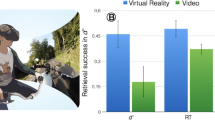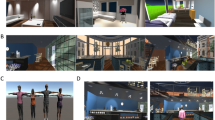Abstract
Recently, it has been claimed that real-life, autobiographical events are processed differently compared to conventional laboratory events. Virtual reality might bridge the gap between real life and laboratory experiences and increase the ecological validity of psychological research. There is broad consensus that self-referential processing is essential for the formation of autobiographical memory. However, it is unclear whether autobiographical experiences can be created with commonly used paradigms, or if self-referentiality is unique to (virtual) reality. We thus set up an experiment in which participants explored a virtual Viking Village either in virtual reality or as a conventional first-person experience on a screen. As hypothesized, virtual reality experiences are vividly retrieved via recollection-based mnemonic processes, which are typical for autobiographical memory. In comparison, conventional screen experiences rather leave a feeling of familiarity. The encoding mechanism in virtual reality might closely resemble real-life mnemonic processing, making VR an ideal tool to study real-life cognition under controlled laboratory conditions.



Similar content being viewed by others
References
Atkinson, R. C., & Juola, J. F. (1973). Factors influencing speed and accuracy of word recognition. Attention and Performance IV, 583–612.
Cabeza, R., Prince, S. E., Daselaar, S. M., Greenberg, D. L., Budde, M., Dolcos, F., LaBar, K. S., & Rubin, D. C. (2004). Brain activity during episodic retrieval of autobiographical and laboratory events: An fMRI study using a novel photo paradigm. Journal of Cognitive Neuroscience, 16(9), 1583–1594. https://doi.org/10.1162/0898929042568578.
Conway, M. A. (2005). Memory and the self. Journal of Memory and Language, 53(4), 594–628. https://doi.org/10.1016/j.jml.2005.08.005.
Curran, T., & Hancock, J. (2007). The FN400 indexes familiarity-based recognition of faces. Neuroimage, 36(2), 464–471.
Diana, R. A., Yonelinas, A. P., & Ranganath, C. (2007). Imaging recollection and familiarity in the medial temporal lobe: A three-component model. Trends in Cognitive Sciences, 11(9), 379–386.
Diemer, J., Alpers, G. W., Peperkorn, H., Shiban, Y., & Mühlberger, A. (2015). The impact of perception and presence on emotional reactions: A review of research in virtual reality. Frontiers in Psychology, 6(JAN). https://doi.org/10.3389/fpsyg.2015.00026.
Fortin, N. J., Wright, S. P., & Eichenbaum, H. (2004). Recollection-like memory retrieval in rats is dependent on the hippocampus. Nature, 431(7005), 188–191.
Gardiner, J. M., & Java, R. I. (1990). Recollective experience in word and nonword recognition. Memory & Cognition, 18, 23–30.
Gorini, A., Griez, E., Petrova, A., & Riva, G. (2010). Assessment of the emotional responses produced by exposure to real food, virtual food and photographs of food in patients affected by eating disorders. Annals of General Psychiatry, 9(1), 30.
Haatveit, B. C., Sundet, K., Hugdahl, K., Ueland, T., Melle, I., & Andreassen, O. A. (2010). The validity of d prime as a working memory index: Results from the “Bergen n-back task”. Journal of Clinical and Experimental Neuropsychology, 32(8), 871–880.
Jacoby, L. L. (1991). A process dissociation framework: Separating automatic from intentional uses of memory. Journal of Memory and Language, 30(5), 513–541.
Jacoby, L. L., & Dallas, M. (1981). On the relationship between autobiographical memory and perceptual learning. Journal of Experimental Psychology: General, 110(3), 306–340.
Jones, T. C., & Jacoby, L. L. (2001). Feature and conjunction errors in recognition memory: Evidence for dual-process theory. Journal of Memory and Language, 45(1), 82–102.
Koen, J. D., & Yonelinas, A. P. (2014). The effects of healthy aging, amnestic mild cognitive impairment, and Alzheimer’s disease on recollection and familiarity: A meta-analytic review. Neuropsychology Review, 24(3), 332–354.
Kvavilashvili, L., & Ellis, J. (2004). Ecological validity and the real-life/laboratory controversy in memory research: A critical and historical review. History and Philosophy of Psychology, 6, 59–80.
Mandler, G. (1991). Your face looks familiar but I can’t remember your name: A review of dual process theory. In E. William, E. Hockley, & E. S. Lewandowsky (Eds.), Relating theory and data: Essays on human memory in honor of Bennet B. Murdock (pp. 207–225). Hillsdale, NJ: Erlbaum.
Mania, K., & Chalmers, A. (2001). The effects of levels of immersion on memory and presence in virtual environments: A reality centered approach. Cyberpsychology & Behavior, 4(2), 247–264.
McDermott, K. B., Szpunar, K. K., & Christ, S. E. (2009). Laboratory-based and autobiographical retrieval tasks differ substantially in their neural substrates. Neuropsychologia, 47(11), 2290–2298.
Nilsson, N. C., Nordahl, R., & Serafin, S. (2016). Immersion revisited: A review of existing definitions of immersion and their relation to different theories of presence. Human Technology, 12(2), 108–134. https://doi.org/10.17011/ht/urn.201611174652.
Parsons, T. D. (2015). Virtual reality for enhanced ecological validity and experimental control in the clinical, affective and social neurosciences. Frontiers in Human Neuroscience, 9, 660.
Rajaram, S. (1993). Remembering and knowing: Two means of access to the personal past. Memory & Cognition, 21(1), 89–102.
Rajaram, S. (1996). Perceptual effects on remembering: Recollective processes in picture recognition memory. Journal of Experimental Psychology: Learning, Memory, and Cognition, 22(2), 365–377.
Renoult, L., Davidson, P. S., Palombo, D. J., Moscovitch, M., & Levine, B. (2012). Personal semantics: At the crossroads of semantic and episodic memory. Trends in Cognitive Sciences, 16(11), 550–558. https://doi.org/10.1016/j.tics.2012.09.003.
Renoult, L., Tanguay, A., Beaudry, M., Tavakoli, P., Rabipour, S., Campbell, K., Moscovitch, M., Levine, B., & Davidson, P. S. R. (2016). Personal semantics: Is it distinct from episodic and semantic memory? An electrophysiological study of memory for autobiographical facts and repeated events in honor of Shlomo Bentin. Neuropsychologia, 83, 242–256. https://doi.org/10.1016/j.neuropsychologia.2015.08.013.
Roediger, H. L., & Marsh, E. J. (2003). Episodic and autobiographical memory. In A. F. Healy & R. W. Proctor (Eds.), The handbook of psychology (pp. 475–497). New York: Wiley.
Rugg, M. D., & Curran, T. (2007). Event-related potentials and recognition memory. Trends in Cognitive Sciences, 11(6), 251–257.
Schöne, B., Wessels, M., & Gruber, T. (2017a). Experiences in virtual reality: A window to autobiographical memory. Current Psychology, 1–5.
Schöne, B., Wessels, M., & Gruber, T. (2017b). Differences between real-life and laboratory memory: Evidence from EEG and virtual reality. Poster session presented at the meeting of Psychologie und Gehirn 2017, Trier.
Schubert, T., Friedmann, F., & Regenbrecht, H. (2001). The experience of presence: Factor analytic insights. Presence Teleoperators and Virtual Environments, 10(3), 266–281. https://doi.org/10.1162/105474601300343603.
Serino, S., & Repetto, C. (2018). New trends in episodic memory assessment: Immersive 360° ecological videos. Frontiers in Psychology, 9, 1878.
Slater, M., Usoh, M., & Steed, A. (1994). Depth of presence in virtual environments. Presence Teleoperators & Virtual Environments, 3(2), 130–144. https://doi.org/10.1162/pres.1994.3.2.130.
Svoboda, E., McKinnon, M. C., & Levine, B. (2006). The functional neuroanatomy of autobiographical memory: A meta-analysis. Neuropsychologia, 44(12), 2189–2208. https://doi.org/10.1016/j.neuropsychologia.2006.05.023.
Swets, J. A., Tanner, W. P., Jr., & Birdsall, T. G. (1961). Decision processes in perception. Psychological Review, 68(5), 301–340.
Tulving, E. (1985). Memory and consciousness. Canadian Psychologist, 26, 1–12.
Yonelinas, A. P. (1994). Receiver-operating characteristics in recognition memory: Evidence for a dual-process model. Journal of Experimental Psychology: Learning, Memory, and Cognition, 20(6), 1341.
Yonelinas, A. P. (1999). The contribution of recollection and familiarity to recognition and source-memory judgments: A formal dual-process model and an analysis of receiver operating characterstics. Journal of Experimental Psychology: Learning, Memory, and Cognition, 25(6), 1415.
Yonelinas, A. P. (2002). The nature of recollection and familiarity: A review of 30 years of research. Journal of Memory and Language, 46(3), 441–517.
Author information
Authors and Affiliations
Contributions
All authors contributed to the study design. Testing and data collection were performed by J. Kisker. J. Kisker and B. Schöne performed the data analysis and interpretation under the supervision of T. Gruber. J. Kisker drafted the manuscript, and B. Schöne and T. Gruber provided critical revisions. All authors approved the final version of the manuscript for submission.
Corresponding author
Ethics declarations
Declaration of Interest
All authors declare that they have no conflict of interest.
Additional information
Publisher’s Note
Springer Nature remains neutral with regard to jurisdictional claims in published maps and institutional affiliations.
Highlights
• VR experiences are vividly retrieved via recollection-based mnemonic processes.
• Recollection-based mnemonic processes are typical for autobiographical memory.
• Conventional screen experiences rather leave a feeling of familiarity.
• VR experiences are characterized by a higher degree of immersion compared to conventional laboratory settings, which lead to such vivid memory traces.
• VR might greatly enrich future research as an experimental tool, bridging the gap between laboratory and real-life experiences.
Rights and permissions
About this article
Cite this article
Kisker, J., Gruber, T. & Schöne, B. Experiences in virtual reality entail different processes of retrieval as opposed to conventional laboratory settings: A study on human memory. Curr Psychol 40, 3190–3197 (2021). https://doi.org/10.1007/s12144-019-00257-2
Published:
Issue Date:
DOI: https://doi.org/10.1007/s12144-019-00257-2




